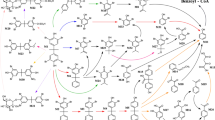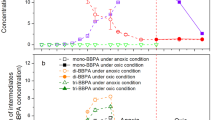Abstract
Laboratory reactor systems based on the conventional (aerobic) activated sludge process and on the contact (anaerobic) process were operated almost one year in order to develop a biological process for the degradation of the fire retardant tetrabromobisphenol A (TBBPA) and to find out if its degradation might result in the formation of the endocrine disruptor bisphenol A (BPA). The reactors were fed a TBBPA waste mixture containing also tribromophenol (TBP), and added with contaminated sediments that might have contained indigenous bacteria exposed to these compounds. Various organic compounds were used as potential electron donors to enhance growth of halorespiring bacteria that would debrominate the TBBPA and make it available for further aerobic mineralization. In spite of the various operating strategies applied and the different carbon sources added, no TBBPA biodegradation has been observed and no accumulation of intermediates such as BPA in any of the aerobic or anaerobic reactors has been detected. TBP on the other hand, was found to be easily biodegraded by aerobic cultures simulating the activated sludge process. This was linked to consistent accumulation of bromides, released to the liquid following TBP breakdown.
Similar content being viewed by others
References
APHA, AWWA, WEF (1992) Standard methods for the examination of water and wastewater, 18th edn. American Public Health Association, American Water Works Association, Water Environment Federation, Washington, DC, USA
Bossert ID, Haggblom MM, Young LY (2003) Microbial ecology of dehalogenation. In: Haggblom MM, Bossert ID (eds) Dehalogenation—microbial processes and environmental applications. Kluwer Academic Publishers
Deweerd KA, Bedard DL (1999) Use of halogenated benzoates and other halogenated aromatic compounds to stimulate the microbial dechlorination of PCBs. Environ Sci Technol 33:2057–2063
Dolfing J (2003) Thermodynamic considerations for dehalogenation. In: Haggblom MM, Bossert ID (eds) Dehalogenation—Microbial processes and environmental applications. Kluwer Academic Publishers
Letcher RJ (2003) The state-of-the-science and trends of brominated flame retardants in the environment: present knowledge and future directions. Environ Int 29:663–664
Loffler FE, Cole JR, Ritalahti KM, Tiedje JM (2003) Diversity of dechlorinating bacteria. In: Haggblom MM, Bossert ID (eds) Dehalogenation—Microbial processes and environmental applications. Kluwer Academic Publishers
Oehlmann J, Schulte-Oehlmann U, Tillmann M, Markert B (2000) Effects of endocrine disruptors on prosobranch snails (Mollusca: Gastropoda) in the laboratory. Part I: bisphenol A and octylphenol as xeno-estrogens. Ecotoxicology 9:383–397
Ronen Z, Abeliovich A (2000) Anaerobic-aerobic process for microbial degradation of Tetrabromobisphenol A. Appl Environ Microbiol 66(6):2372–2377
Author information
Authors and Affiliations
Corresponding author
Additional information
Special Issue on Biomarkers of Marine Pollution and Bioremediation
Rights and permissions
About this article
Cite this article
Brenner, A., Mukmenev, I., Abeliovich, A. et al. Biodegradability of tetrabromobisphenol A and tribromophenol by activated sludge. Ecotoxicology 15, 399–402 (2006). https://doi.org/10.1007/s10646-006-0072-6
Accepted:
Published:
Issue Date:
DOI: https://doi.org/10.1007/s10646-006-0072-6




